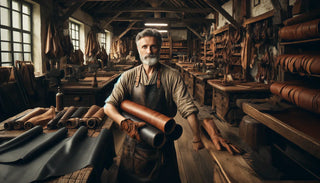Thinking about buying a leather piece—maybe a rugged jacket, a sleek bag, or a statement sofa? Before you swipe that card, there's one big decision to make: real leather or fake leather? This guide goes beyond the surface to help you understand what you're really paying for.
The Basics: What Makes Leather Real or Fake?
Real leather is made from animal hide, usually buffalo, goat, or lamb. It's a natural material with unique textures, a rich scent, and a lifespan that can stretch over decades.
Fake leather, often called synthetic leather, vegan leather, or faux leather, is made from synthetic material like polyurethane (PU) or PVC. It's cheaper, comes in bold colors, and is widely used in fast fashion.
Types of Leather: Not All Leather Is Created Equal
-
Full grain leather – Top-quality with natural imperfections intact; strong and breathable.
-
Top grain leather – Sanded and finished for a cleaner look while remaining durable.
-
Bonded leather – Made from leather scraps and glue; not very durable.
How Can You Tell the Difference?
Leather has a distinct feel and look. It’s warm, textured, and changes over time. Leather smells earthy and natural. Fake leather, on the other hand, feels colder, may appear too perfect, and often smells like chemicals.
Side-by-Side: Real vs. Fake Leather
| Category | Real Leather | Fake Leather |
|---|---|---|
| Source | Made from animal hide | Created from synthetic material |
| Look & Feel | Natural texture, develops patina | Uniform, lacks depth |
| Smell | Leather smells rich and earthy | Synthetic or plastic-like |
| Durability | Can last decades | Prone to scratch easily, cracking |
| Comfort | Breathable and adapts to your body | Less breathable |
| Maintenance | Needs conditioning every few months | Low maintenance |
| Environment | Natural material, biodegradable | Not biodegradable, petroleum-based |
| Ethics | Made from real animal byproducts | Marketed as vegan leather |
| Cost | Higher price tag, long-term value | Budget-friendly, disposable |
Real Leather in Everyday Life
When you buy a leather product made from real hide, you're not just buying material—you're buying a story. Real leather softens with time, takes on character, and becomes a staple in your life.
Leather and faux leather may seem close at first glance, but leather on the other hand will look better and feel better the more you use it.
What About Sustainability?
-
Real leather is biodegradable, especially when vegetable-tanned. If you’re looking for something to last 20+ years, this is your best bet.
-
Fake leather avoids real animal use but is often petroleum-based, making it less eco-friendly in the long run.
Do You Need to Baby Your Leather?
Caring for Real Leather:
-
Clean with a damp cloth
-
Condition with a leather balm every 3–6 months
-
Keep it in a cool, dry place
Caring for Fake Leather:
-
Wipe with mild soap and water
-
Avoid direct heat or sunlight
-
Use a synthetic-safe protectant spray
How Much Should You Spend?
It depends on what you want:
-
If you’re looking for timeless style and durability, real leather is worth the price tag.
-
If you want something trendy or temporary, fake leather might do just fine.
The Honest Pros & Cons
Real Leather Pros:
-
Made from animal hide
-
Long-lasting, durable
-
Softens and gains character
Real Leather Cons:
-
More expensive
-
Require frequent maintenance
Fake Leather Pros:
-
Vegan leather, cruelty-free
-
Inexpensive and versatile
-
Easier to clean
Fake Leather Cons:
-
Synthetic material, not breathable
-
Not biodegradable
-
Can scratch easily and peel
Now that you know how real leather stacks up against synthetic alternatives — in terms of durability, texture, smell, and aging — it’s easy to see why it’s worth the investment. If you're ready to skip the guesswork and go straight for the good stuff, take a look at our real leather jackets. These are the kind of pieces that not only look better over time but also hold up for years when cared for properly.
Frequently Asked Questions
How do I spot real leather in a store?
Touch it and smell it. Real leather has a rich, uneven grain and a signature scent. If it smells plasticky, it’s probably synthetic.
Is bonded leather a good choice?
It’s technically genuine leather, but it’s made from leftovers. It’s more affordable but not as durable as top grain leather or full grain leather.
Is vegan leather always better for the environment?
Not always. While it avoids real animal products, many vegan leather items are made with plastics that don’t break down easily.
What kind of leather is best for a jacket?
Go for full grain leather if you want long-term wear and patina. It may cost more, but it lasts longer and looks better.
Does fake leather peel easily?
Yes, especially under heat and moisture. That’s one reason many fake leather jackets don’t last more than a couple of seasons.
Final Verdict
If you want a timeless piece that grows with you and stands up to wear, choose real leather. It’s strong, breathable, and has unmatched depth and character.
Fake leather can work if you’re after quick trends or low-maintenance options, but it rarely offers the same value.
Choose real. Choose quality. Choose leather that lives with you.


